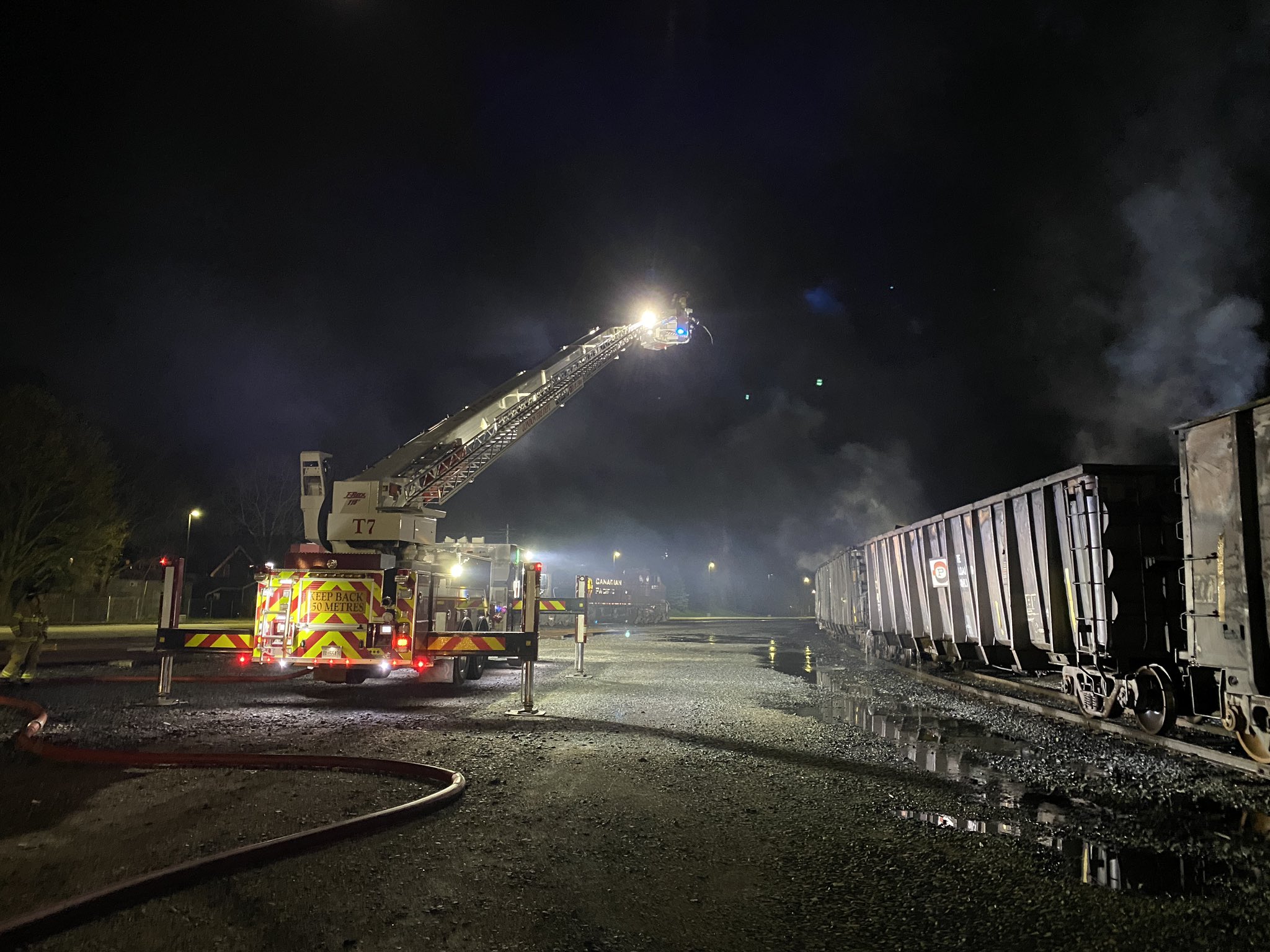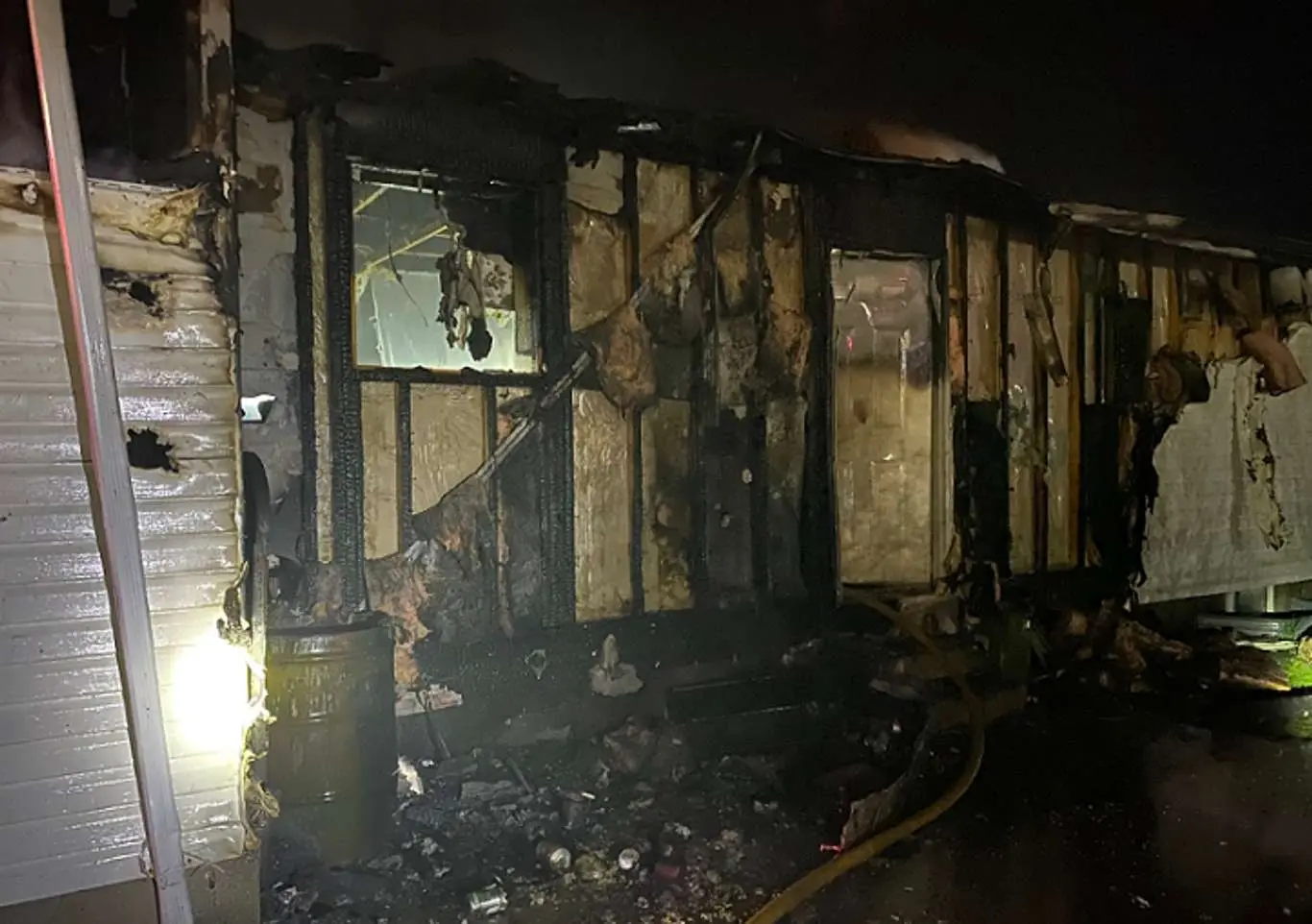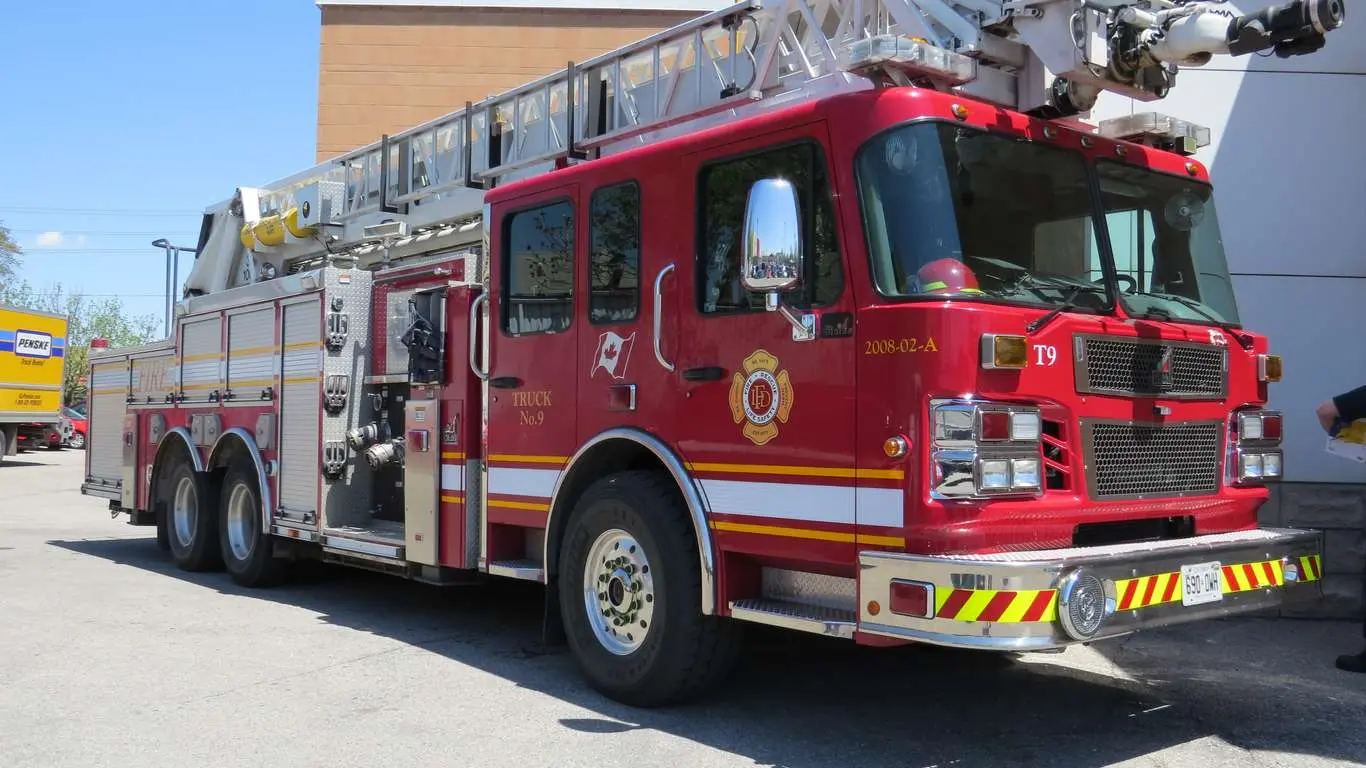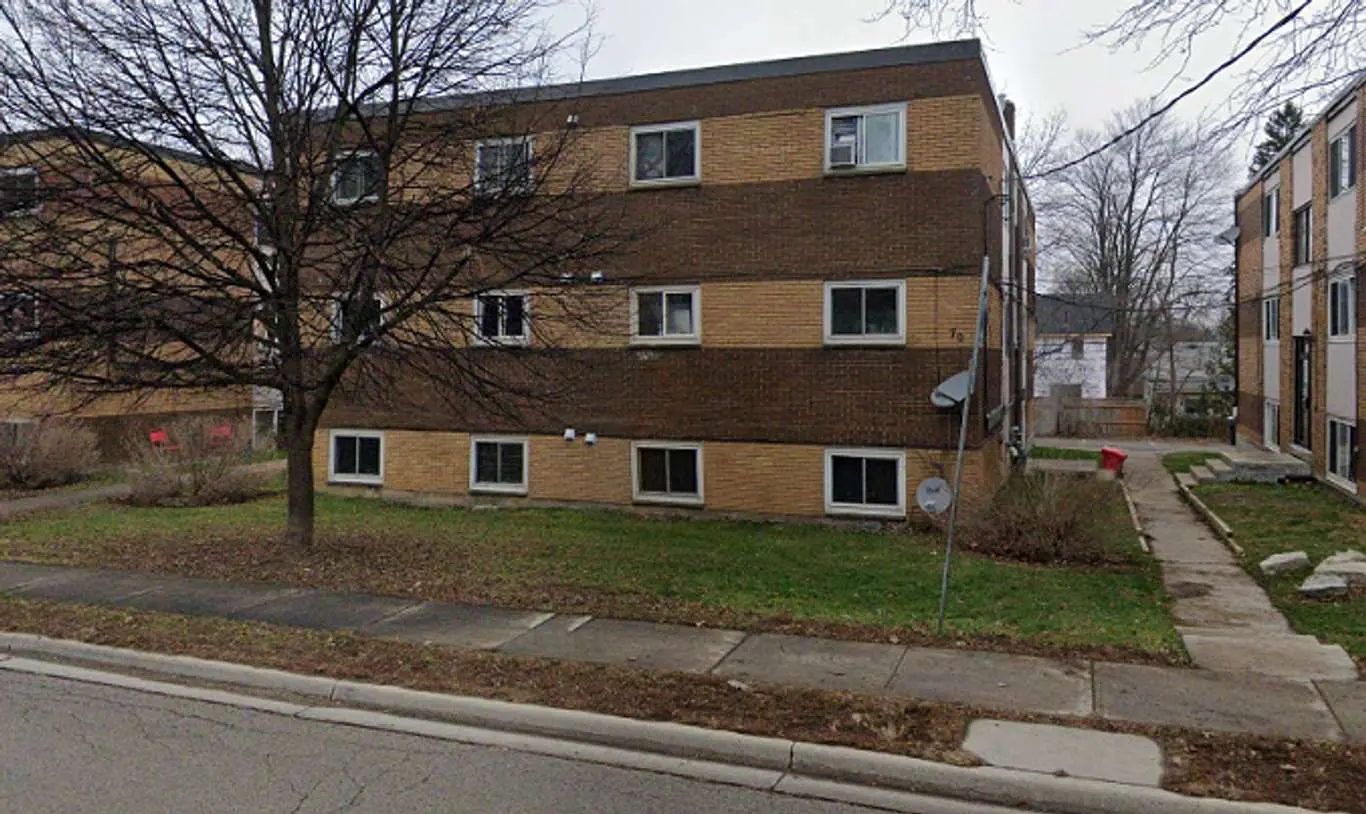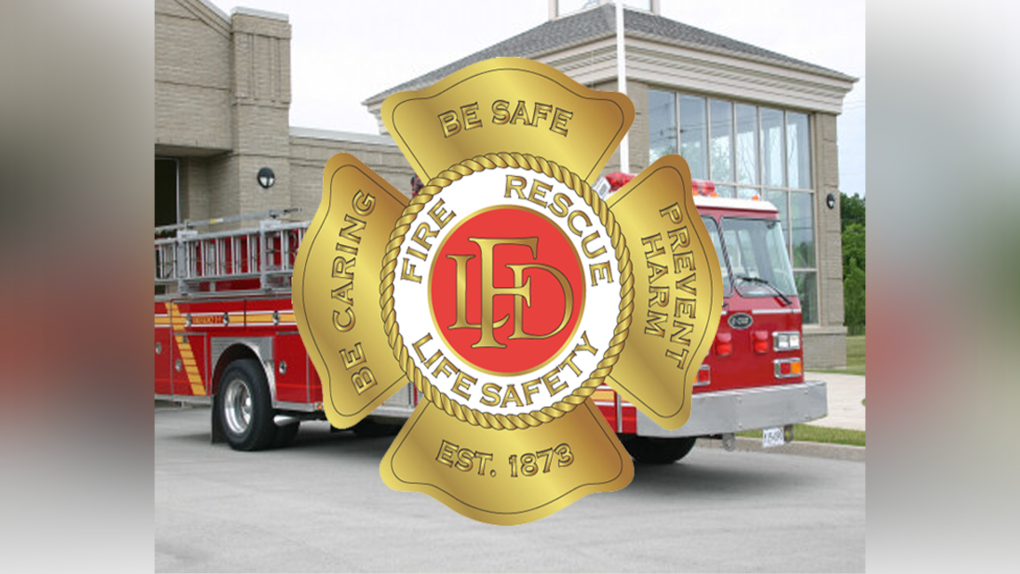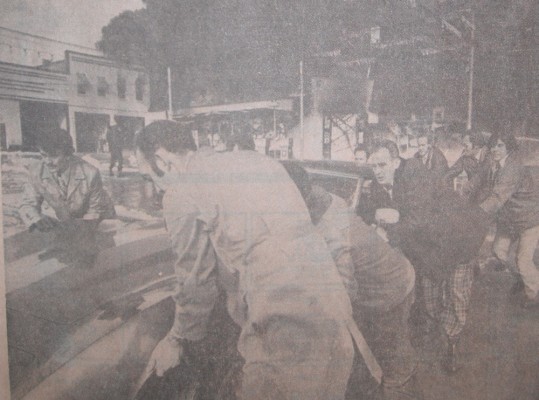
Central Chev Olds employees push one of their cares to safety as the $1-million fire blazes in the background. (Photo by Bill Ironside of The Free Press)
By John Matsui of the London Free Press
Electrical power to the downtown area was turned off for about a half-hour Thursday so Public Utilities Commission workers could prevent the spread of an underground blaze caused by the fire at Central Chevrolet Oldsmobile.
PUC operations manager Gerald Claxton said he believes flames from the car dealership travelled along electrical ducts to the power lines below the street level.
When insulation around the cable melted or burned the lines short-circuited and sent off sparks which contributed to the underground fire, said Mr. Claxton.
Although Mr. Claxton described the situation as “no more than a severe sparking condition”, a PUC foreman at the scene said built-up underground gases probably caused an explosion and a number of lesser flare-ups to erupt from a manhole in the middle of Fullarton Street.
Mr. Claxton said he doesn’t know the extent of damage to PUC equipment and couldn’t estimate the cost of repairs until after PUC officials make a complete study.
“It’s suffice to say the area around the building is damaged… There are going to have to be areas that have to be replaced, but it isn’t too big an area.”
Once power was cut off to the area bounded roughly by Waterloo, Ridout and Maple Streets and the CNR tracks, the sparking stopped and flames subsided, Mr Claxton said.
This allowed PUC workers to enter manholes and isolate the block where the car dealership fire occurred from the of the city’s electrical system.
The London Free Press stopped production for more that a half-hour as lights blinked off and computers shut down. Although outside the boundaries described by Mr. Claxton, he pointed out that in some instances buildings such as The Free Press, which receives power from the core area, would have been affected.
City Hall and a number of office buildings were left in the dark for half an hour, but none apparently encountered any major difficulties.
Regular telephone service remained intact although business telephones operating through a switchboard were inoperable, according to a Bell Canada repairman.
After officials at the Eaton’s store in Wellington Square realized the blackout would last more than a few minutes, they evacuated the store, assistant manager Ken Bathurst said.
He said the evacuation was carried out “for safety reasons only.” Despite the fact the store had some emergency lighting, he said there were dark areas and some lox fixtures where customers could have been injured.
Although customers in the Roert Simpson store at Richmond and Dundas streets weren’t told to leave, they were informed no one would be served until power was restored, manager Terry Bryant said.
Those who wished to leave were escorted out by employees carrying flashlights, one employee said.
Mr Bryant said the store has a team of persons who have been trained for such occasions, and the whole operation worked “just like a fire drill.”

Central Chev Olds employees push one of their cares to safety as the $1-million fire blazes in the background. (Photo by Bill Ironside of The Free Press)
By John Matsui of the London Free Press
Electrical power to the downtown area was turned off for about a half-hour Thursday so Public Utilities Commission workers could prevent the spread of an underground blaze caused by the fire at Central Chevrolet Oldsmobile.
PUC operations manager Gerald Claxton said he believes flames from the car dealership travelled along electrical ducts to the power lines below the street level.
When insulation around the cable melted or burned the lines short-circuited and sent off sparks which contributed to the underground fire, said Mr. Claxton.
Although Mr. Claxton described the situation as “no more than a severe sparking condition”, a PUC foreman at the scene said built-up underground gases probably caused an explosion and a number of lesser flare-ups to erupt from a manhole in the middle of Fullarton Street.
Mr. Claxton said he doesn’t know the extent of damage to PUC equipment and couldn’t estimate the cost of repairs until after PUC officials make a complete study.
“It’s suffice to say the area around the building is damaged… There are going to have to be areas that have to be replaced, but it isn’t too big an area.”
Once power was cut off to the area bounded roughly by Waterloo, Ridout and Maple Streets and the CNR tracks, the sparking stopped and flames subsided, Mr Claxton said.
This allowed PUC workers to enter manholes and isolate the block where the car dealership fire occurred from the of the city’s electrical system.
The London Free Press stopped production for more that a half-hour as lights blinked off and computers shut down. Although outside the boundaries described by Mr. Claxton, he pointed out that in some instances buildings such as The Free Press, which receives power from the core area, would have been affected.
City Hall and a number of office buildings were left in the dark for half an hour, but none apparently encountered any major difficulties.
Regular telephone service remained intact although business telephones operating through a switchboard were inoperable, according to a Bell Canada repairman.
After officials at the Eaton’s store in Wellington Square realized the blackout would last more than a few minutes, they evacuated the store, assistant manager Ken Bathurst said.
He said the evacuation was carried out “for safety reasons only.” Despite the fact the store had some emergency lighting, he said there were dark areas and some lox fixtures where customers could have been injured.
Although customers in the Roert Simpson store at Richmond and Dundas streets weren’t told to leave, they were informed no one would be served until power was restored, manager Terry Bryant said.
Those who wished to leave were escorted out by employees carrying flashlights, one employee said.
Mr Bryant said the store has a team of persons who have been trained for such occasions, and the whole operation worked “just like a fire drill.”

